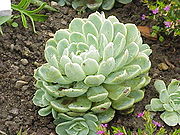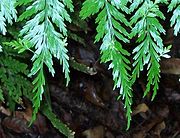
The Crassulaceae, also known as the stonecrop family or the orpine family, are a diverse family of dicotyledon flowering plants characterized by succulent leaves and a unique form of photosynthesis, known as Crassulacean acid metabolism (CAM). Flowers generally have five floral parts. Crassulaceae are usually herbaceous but there are some subshrubs, and relatively few treelike or aquatic plants. Crassulaceae are a medium-sized monophyletic family in the core eudicots, among the order Saxifragales, whose diversity has made infrafamilial classification very difficult. The family includes approximately 1,400 species and 34–35 genera, depending on the circumscription of the genus Sedum, and distributed over three subfamilies. Members of the Crassulaceae are found worldwide, but mostly in the Northern Hemisphere and southern Africa, typically in dry and/or cold areas where water may be scarce, although a few are aquatic.
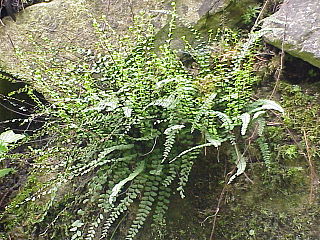
Asplenium is a genus of about 700 species of ferns, often treated as the only genus in the family Aspleniaceae, though other authors consider Hymenasplenium separate, based on molecular phylogenetic analysis of DNA sequences, a different chromosome count, and structural differences in the rhizomes. The type species for the genus is Asplenium marinum.

Sempervivum is a genus of about 40 species of flowering plants in the family Crassulaceae, commonly known as houseleeks. Other common names include liveforever and hen and chicks, a name shared with plants of other genera as well. They are succulent perennials forming mats composed of tufted leaves in rosettes. In favourable conditions they spread rapidly via offsets, and several species are valued in cultivation as groundcover for dry, sunny locations.

Jovibarba is a small genus of three species of succulent flowering plants in the family Crassulaceae, endemic to mountainous regions in the southeastern quadrant of Europe. The genus is sometimes classified as a subgenus of Sempervivum, to which it is closely related. Jovibarba have pale-greenish-yellow or yellow actinomorphic flowers with about six petals, while Sempervivum have generally pinkish flowers with around twice as many petals, which open more widely than jovibarba flowers. The common name hen and chicks is applied to some Jovibarba species.

Hen and chicks is a common name for a group of small succulent plants. They belong to the flowering plant family Crassulaceae, native to southern Europe and northern Africa. The plants grow close to the ground with leaves formed around each other in a rosette, and propagating by offsets. The "hen" is the main, or mother, plant, and the "chicks" are a flock of offspring, which start as tiny buds on the main plant and soon sprout their own roots, taking up residence close to the mother plant.

Echeveria is a large genus of flowering plants in the family Crassulaceae, native to semi-desert areas of Central America, Mexico and northwestern South America.

Chlorophytum comosum, usually called spider plant or common spider plant due to its spider-like look, also known as spider ivy, airplane plant, ribbon plant, and hen and chickens, is a species of evergreen perennial flowering plant of the family Asparagaceae. It is native to tropical and Southern Africa but has become naturalized in other parts of the world, including Western Australia and Bangladesh. Chlorophytum comosum is easy to grow as a houseplant because of its resilience, but it can be sensitive to the fluoride in tap water, which commonly gives it "burnt tips". Variegated forms are the most popular.
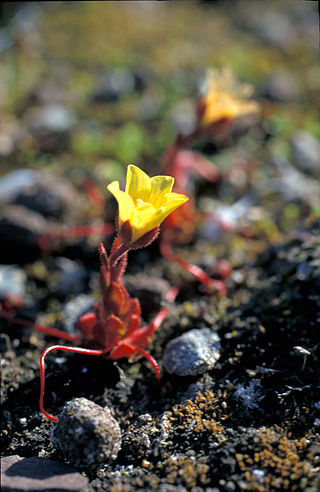
Spider plant is a common name for several plants and may refer to:

Dudleya, commonly known as liveforevers is a genus of rosette-forming succulent plants in the stonecrop family, Crassulaceae, consisting of about 68 taxa in southwestern North America and Guadalupe Island. The species come in many forms, some large and evergreen, others geophytic and deciduous. Yet, despite their dramatic variations in appearance, most species readily hybridize. The flowers of Dudleya have parts numbered in fives, with the petals arranged in tubular, star-shaped, and bell-shaped forms and, when fruiting, are filled with tiny, ovoid-crescent-shaped seeds.

Sempervivum tectorum, the common houseleek, is a species of flowering plant in the family Crassulaceae, native to the mountains of southern Europe, cultivated in the whole of Europe for its appearance and a Roman tradition claiming that it protects buildings against lightning strikes.
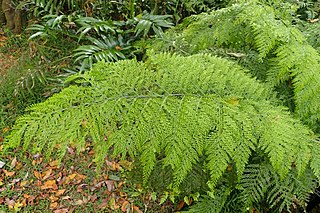
Asplenium bulbiferum, known as mother spleenwort, is a fern species native to New Zealand only. It is also called hen and chicken fern and, in the Māori language, pikopiko, mouku or mauku. Its fronds are eaten as a vegetable.
Pikopiko is a Māori word for the young curled shoots of ferns. The pikopiko was one of the foods that was eaten at Matariki feasts. Once harvested, pikopiko can be peeled and washed to remove the bitterness, then steamed, boiled, stir-fried, chopped and added to bread dough, blended with oil and nuts to make a spread or simply used as an attractive and delicious garnish. It may refer to a range of fern species including:

Echeveria elegans, the Mexican snow ball, God's Throne, Mexican gem or white Mexican rose is a species of flowering plant in the family Crassulaceae, native to semi-desert habitats in Mexico.
Welcome-home-husband-though-never-so-drunk is a common name for several succulent plants and may refer to:
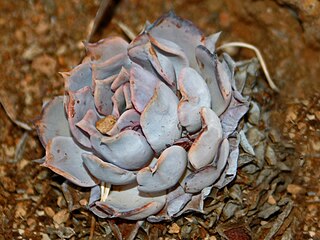
Echeveria lilacina, common name ghost echeveria or Mexican hens and chicks, is a species of succulent plants in the genus Echeveria belonging to the family Crassulaceae.
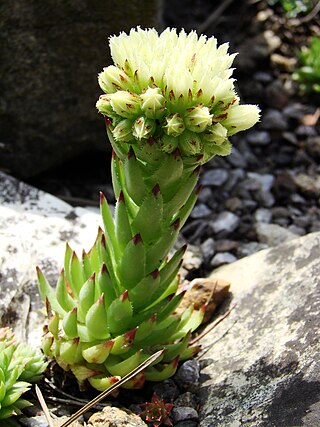
Jovibarba globifera, common name rolling hen-and-chicks, is a species of succulent flowering plant in the family Crassulaceae.
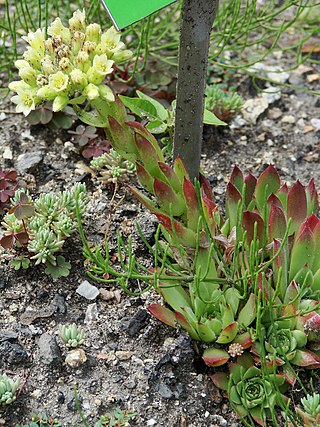
Jovibarba heuffelii, common name hen-and-chickens, as a plant species native to the Balkans and to the Carpathians in Europe but reportedly naturalized in Wisconsin and probably in other parts of North America. It grows on rocky outcrops.
Hen and chicken, or variations, may refer to:

Sempervivoideae is the largest of three subfamilies in the Saxifragales family Crassulaceae, with about 20–30 genera with succulent leaves. Unlike the two smaller subfamilies, it is distributed in temperate climates. The largest genus in this subfamily is Sedum, with about 470 species.

Asplenium gracillimum is a fern species native to Australia and New Zealand, also found in Stewart Island and the Chatham Islands. The specific epithet gracillimum refers to the slender and graceful appearance of this fern.



